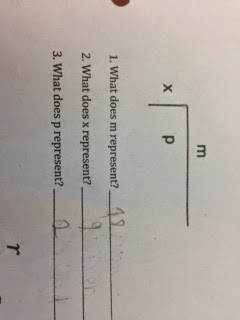MA.4.a Apply number theory concepts, including prime factorization and relatively prime numbers, to the solutions of problems.
The Learning Objective: Factor a composite number down to all prime numbers
Quote of the Day: “ ‘There’s plenty of blame to go around!’ Really? Does there need to be? Can’t we just move on and solve the problem.” - John G. Miller from The Question Behind the Question
Agenda:
- Jumpstart --> In one class we picked math partners for the first time and in the two others we did Connect Four since each class had not done this activity yet, but had done the other.
- We reviewed the homework. Students struggled with the idea that 121 was a composite number initially (this was a big deal the day before for me that they really think before declaring a prime).
- We took notes on prime factorization
- Students did a problem independently using the "birthday cake method" (see picture below)
- As students entered class for a second time I did another formative assessment using the number 13 as a factor because I was confident they would struggle when I stepped away from the 2, 3, 5 prime number comfort zone.
- Students worked with a math partner on the homework. I told one class to start with word problems thinking they would want to struggle with the challenges with me in the room rather than doing it at home.
The Assessment: I'd like to think there were four today. First of all, almost every morning as students get to their lockers I'm holding up a marker board with a basic problem from the day before. Today I asked is 91 was prime or composite. One out of nineteen students said that it was composite - and that student couldn't tell me what factors produced 91 other then 1 and 91. Obviously this is a tough problem to do mentally, but that so many students would instantly conclude that 91 was prime concerned me. As I told each one that they were wrong, I sensed a greater degree of caution in class on numbers such as 1001 (7 x 11 x 13).
The second assessment was me looking at their homework. Students clearly know the definition of prime and composite. Every student correctly identified even numbers as composite. That said, they are still struggling with numbers that are divisible by 3. Number like 129 and 57 were tripping them up. Also the aforementioned 121 was difficult, but it was nice to see so many students perk up when I declared the numbers were composite and they saw what number caused this.
The third assessment was a bit more of a cupcake. I had them factor either 210 or 105 as a fourth example in their class notes. They passed this with flying colors.
The last assessment was the students entering the room doing the problem featured in the picture above and also below. It's always painful to see a student understand the process, but simply miss one step in the calculation process. The student even started to do it out, but then erased it (see the top right of the picture in lighter looking pencil) thinking that 2 went into 78 only 34 times.
Homework: Tonight I had the students practice 8 numbers including the difficult 1001 to find prime factors for. I also asked theory questions such as why 2 is only the even prime number and if someone's lock combination involved a prime factor of 435 what could the combination number possibly be?
My Glass Half-Full Take: I didn't even mention that I was circumventing the room for about twenty-five minutes as they started the homework. I feel confident in my assessments that the students understand how to get the prime factors of a number.
One Thing to Do Differently: In a month, if I give the directions "write 96 as a product of prime numbers" I still feel like the class will have difficulty. If I gave the directions "make 96 a birthday cake" or "make 96 a factor tree" they will pass the test with flying colors. Thus, I'm going to ask them in a month "write 96 as a product of prime numbers." And if they don't get it, we'll see it again two weeks thereafter.
Link of the Day: In the theme of prime and composite, why one is the loneliest number.




























